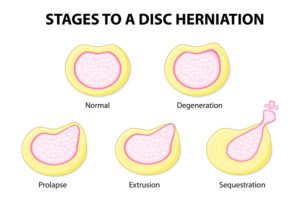Degenerative Disc Disease
As we age, the spinal discs start to dehydrate (the discs are 80% water at birth). As a result of this loss of water over time, the discs start to stiffen. This means they are less able to adjust to the compression forces of every day activities. Although this is considered a part of the natural ageing process, in some individuals, it can cause pain. 
This is known as Degenerative Disc Disease, and it is one of the most common causes of lower back pain. However it is also the most misunderstood.
That is partly because few medical professionals agree on exactly what a diagnosis of Degenerative Disc Disease means, and also when exactly, it is the cause of back pain. The symptoms of Degenerative Disc Disease can be quite varied, and this just makes it even more difficult to diagnose.
Maybe not surprisingly, Degenerative Disc Disease is almost universal in the population. The discs can start to show degenerative changes as early as in our 20’s. Most people will have varying degrees of mild to moderate Degenerative Disc Disease by the time they are in their 30’s. Some are even severe by this age.
Strangely though, not everyone experiences pain. One person may have crippling pain, whilst someone else may have no pain at all. This is one of the difficulties of knowing when, and how to treat Degenerative Disc Disease.
Signs of Degenerative Disc Disease:
Although it varies widely, signs of Degenerative Disc Disease generally follow a pattern.
Pain in the midline (not off to one side)
Intermittent back pain (flares up from time to time) but generally does not get worse over time.
Pain is often worse with weight bearing, and improves with lying down.
Pain aggravated by physically demanding activity.
Pain aggravated by forward bending, particularly for extending time periods (sitting, working at a bench).
The pain from Degenerative Disc Disease is due to a combination of inflammation and instability of the spinal segment (which puts further stress on the surrounding tissues).
As the discs degenerate, they lose water and start to shrink, losing height and the ability to flex and absorb pressure. This process is often sped up as a result of poor posture, sedentary lifestyle, lots of sitting, and incorrect movement patterns. It is even worse if there has been an injury, particularly if a twisting injury has damaged the disc at some point.
The shrinking disc is a telling sign of Degenerative Disc Disease. It is easily visualised on X-rays, where you can see a decrease in the space for the disc (white arrow below).

Treatment options for Degenerative Disc Disease.
Medications such as pain killers and anti-inflammatories can relieve the pain, but do not fix the underlying problem.
Spinal surgery, usually fusion, has unreliable outcomes and a long recovery time. Surgical intervention of any kind is fraught with risks and can lead to further complications down the line. In severe cases this may be the only option, but all other possible avenues should be tried first.
Chiropractic manipulation can increase spinal range of motion, relieve nerve pressure, restore blood flow and reduce muscle tension. It is low risk and has a very good success rate.
Ultrasound and massage can help to restore blood flow and reduce muscle tension.
A specific exercise program designed to progressively stabilise the spine and increase flexibility is often the only way to achieve long-term healing for most sufferers of Degenerative Disc Disease.
Hot and cold therapy, losing weight and quitting smoking are all known to be beneficial as well.